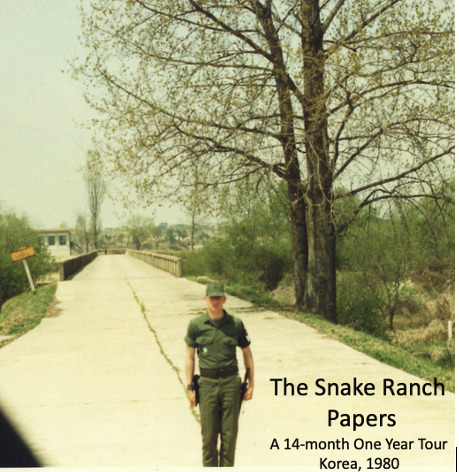Introduction to an Incorrect World

(The image above was taken in May of 1980 from an Army tour bus in the Joint Security Area (JSA) in the De-Militarized Zone just south of the armistice line between the ROK and North Korea. The young officer standing to attention at the approach to what was known as the “Bridge of No Return.” It was widely known at the time that no one did. There is a dark speck at the northern end that is a North Korean guard on his side of the Border. Peace in the JSA was then a generalized concept. Still “news” in that period was the recent murder of two US army personnel who were attempting to trim a tree which had grown to obstruct the view near the crossing point. The rest of that film roll exists, now in digital format. We will include a compilation of the images with the manuscript should we get around to it.)
– Vic
Introduction to an Incorrect World
The Snake Ranch Papers is one of those things that has followed our group around since 1981. Reading it now suggests the authors- 29-year-olds then- were what today’s reference terms would call alcohol-dependent xenophobes. All things are relative, and sequentially this had been intended to follow the first book (“The Adventures of Nick Danger, Third Eye”) scribbled during the previous years embarked as part of Carrier Air Wing FIVE on USS Midway (CV-41).
In that period, the ship was home-ported in Yokosuka, Japan, in order to minimize response time to events in the western Pacific from ships based on the U.S. West Coast. The ship was kind enough to publish a series of noir Private Detective stories during two deployments to the Indian Ocean. One of them had been scheduled with goodwill visits to Australia and Kenya and interrupted by the seizure of the US Embassy in Tehran by student militants. The other was a more impromptu affair due to a collision at sea suffered by USS Ranger (CV-61).
Technical developments continued quite independent of international affairs. By 1989, information was available by satellite from off-ship sources. When Forrestal (CV-59) deployed to the Med, production of a sequel to Nick Danger entitled “The Adventures of Rex Bueno” gained no traction with afloat management and the crew. That story then died after a few furtive episodes in the ship’s paper. So, “The Snake Ranch Papers,” recently discovered, is the remaining account of a technological transitional year spent in the ROK during a tumultuous military coup. It represents a time when distance was still real and attempts to tell stories about it represented a vestige of communications in the (almost) pre-digital age.
In that context, there was a time when triplicate forms- that is to say “3 pieces of paper stuck together at the top with some inky stuff in between the bottom ones” were used at many Defense offices to provide “original” and two “file” copies to normal outgoing correspondence. In 1980, Xerox machines were still new technology and overlapped the older paperwork formats. Both functions were at odds. The old paper ones limited distribution to a very small group on paper and the new electrical ones opening it wildly to another.
The internet revolution was emerging as well, eliminating the safety that would have saved at least one career we know of due to use of that “reply to all” button on the computer screen. But that is a demonstration of time and change. Four decades ago, things were “typed” on “triplicate” forms and later scanned, digitized, transformed into .pdf format and back again to multiple releases of a program widely known “Microsoft Word.”
The original manuscript depicting the Snake Ranch, a modest Army housing structure also known as a “Hooch,” was in sheets of that annoying thin paper with the scars at the top where the copies were separated. The “copy” pages were held after being ripped apart, the top copy “mailed” with the copy retained and slid into a folder kept in the little desk in the six-man hooch on South Post, in the Yongsan Military Garrison in Seoul, Republic of Korea. A word of warning should you eventually see it- they are partially fiction and were intended to be the sensational basis of something else more significant later.
In the mid-1990s we wondered what our hosts on a CODEL to Pyongyang, DPRK, might have thought about the contents. We hoped then to be permitted to return south of that Bridge we once looked to the north of.
The folder was dragged to Hawaii when eventually the Republic of Korea and the 8th US Army was done with the narrators. At some point- we suspect at the Fleet Ocean Surveillance Information Center- Pacific (FOSIC Pac) at Pearl Harbor it was processed, page by page, through one of the big copiers we used back in the old days. It was then transformed from ink-on-paper to digital format on a scanning device and rendered as ‘portable document files’ (.pdf). It was stored on several of those thin square magnetic “floppy discs” with the little window in the protective sleeve that served to transfer the digital version across the last dozen home computers we have managed across fifty or sixty upgrades to two major operating systems. Only one of the floppies survives, quite dusty. We have not seen a device to read it in more than a decade.
The Writer’s Section at Refuge Farm took a poll this morning about “suitability” of the manuscript and will not inflict it on you this morning. Advances in technology permit the abbreviation of ancient words into something more (or less) intelligible. It is a welcome advance in social affairs in which we have turned all that stuff over to Facebook.
– Vic
Copyright 1980 and 2022 Vic Socotra
www.vicsocotra.com
